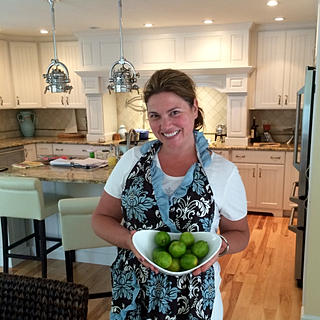Earl Grey Tea. A Splendid Cup of Tea with a Tasty Tale of Creation
- Tricia Cohen
- Feb 12, 2017
- 4 min read
Updated: Dec 18, 2022

Where does the name Earl Grey come from? As with other food origins, there are many engaging stories on how the name came to be.
A long-told tale states the origination comes from a grateful Chinese tea blender. The man gifted a blend of tea and its recipe in 1803 to Lord Grey as a thank-you for saving his son from drowning in China. The recipe called for the scenting and flavoring of black tea with bergamot oil. Lovely tale but a wee bit of a stretch as Lord Grey never went to China, and more importantly, bergamot oil was not used at the time to scent tea. Legend two speaks of the accidental blending that occurred when a gift of tea shipped from China with bergamot oranges. The orange scent permeated the tea, creating a lovely fruit flavor when the tea arrived. Maybe. The third version, which is the most probable, involves a Chinese friend of Grey who was visiting the Earl. It was said that he did not care for the taste of the minerals (specifically, lime) in the water at Howick Hall and blended bergamot with his tea to his liking.

Though it is not clear the exact origin of the name, we do know who "Grey" is, Charles Grey, the 2nd Earl of Grey (1764-1845). Charles was named the 2nd Earl in 1807 after his father passed. The first Earl Grey, Charles “No Flint” Grey, was a decorated British Major General during the American Revolutionary War. The first Grey has nothing to do with the tea, but he had his place in history. He earned his nickname at the Paoli battle in Pennsylvania. Grey ordered his troops to remove the flints from their muskets to prevent the men from discharging their weapons, which would alert the colonists to their position. He also led the British in the Baylor Massacre (New Jersey) Battle of Germantown and raided New Bedford and Martha’s Vineyard in 1778 before returning to England. Upon his return to England, Grey became a knight and was promoted to Lieutenant General.
Charles, the second, was a highly educated English aristocrat elected to Parliament at 22. Grey was highly respected, which explains his quick rise in politics, though it has been said that he was not loved. As a prominent Whig, Grey became Prime Minister in 1830. Grey brought about governmental reform in his brief time in office. He was the author of the Reform Bill of 1832, which proposed wide-ranging changes to the electoral system due to inequalities in representation between the rural areas and the industrial cities in England. His most notable act was the Slavery Abolition Act of 1833. Grey retired from political life in 1834, living the rest of his days with his family, books, and dogs until he died in 1845. Before Grey’s long marriage with Mary Elizabeth Ponsonby, he had an illegitimate daughter with the Duchess of Devonshire, the subject of the 2008 movie “The Duchess” (Keira Knightly). Though the tea was named after this colorful historical character, the Grey family never received a penny for their namesake.
Back to the tea…
Earl Grey tea is a black tea flavored with the oil from the rind of a bergamot orange. This fragrant orange is a fruit mostly grown in Italy and tastes like a Meyer lemon. Tea grew in popularity in England during the 1800s because of a company called Twinings. Ironically the first company to produce the tea was Jacksons of Piccadilly, which Twinings now own. The British prefer to drink their Earl Grey with lemon, which compliments the bergamot's subtle citrus flavor.

Who knew there were so many varieties of Earl Grey?
The Ladies Grey. Lady Grey is a blend of Earl Grey with blue cornflower blossoms, Lavender Lady Grey includes lavender, and Citrus Lady Grey combines lavender and Seville oranges
French Earl Grey is a blend of rose petals.
Russian Earl Grey often contains ingredients such as citrus peels and lemongrass.
Earl Grey White or "Earl White" tea combines white tealeaves with bergamot flavoring.
Roobios Earl Grey is a South African herbal tea that contains rooibos and bergamot.
A beverage called "London Fog" is a combination of Earl Grey, steamed milk, and vanilla syrup. Yum!
The tea has its place in culinary history within the British Isles as a drink mixed with gin. Following the controversial Weights and Measures Act in 1855, working-class British households looked for ways to combine the drink with minimum-proof alcohol. The unplanned benefit of this drink came from the preparation. Boiling the water for tea along with the alcohol helped rid the water-born contaminants.

In the culinary world, Earl Grey tea is becoming more popular in recipes. The tea is often used in cakes, confections, and chocolates, but there are many delicious savory recipes. It does not take much effort to find delicious recipes that are complimented by the ingredient. In my cookbook, An Unofficial Poldark Cookbook, I made Earl Grey Tea Pots de Creme. Within seconds of my first bite, I was immediately taken back to my childhood when my grandmother would make us "comfort tea" when we were upset or feeling ill. My grandmother went against the grain and served Earl Grey tea with milk, but we didn't care. For us, her tea had healing powers.
There is also some talk about the medical benefits of drinking this fine beverage. The tea is said to be beneficial for your teeth (fluoride is a natural component), digestion, mood, and skin (antioxidants).
With that all said, enjoy your afternoon with a lovely cup of tea and a side of lemon. Cheers.
From the Unofficial Poldark Cookbook :


"Bring me a cup of tea and the Times."
- Queen Victoria's first command upon her Accession to the throne





